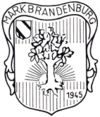State of Brandenburg (1947–1952)
| flag | coat of arms |
|---|---|

|

|
| Situation in the GDR | |

|
|
| Consist | 1947-1952 |
| State capital | Potsdam |
| surface | 27,612 km² |
| Residents | 2,725 million (1950) |
| Population density | 98 inhabitants / km² |
| Arose from | Mark Brandenburg Province |
| Incorporated into | Districts Cottbus , Frankfurt (Oder) , Neubrandenburg , Potsdam , Schwerin |
| Today part of | Brandenburg , Mecklenburg-Western Pomerania , Saxony-Anhalt |
The state of Brandenburg (initially Land Mark Brandenburg ) was established in 1947 as a member state of the future German Democratic Republic (GDR). Until the founding of the GDR in 1949, it formed part of the Soviet Occupation Zone (SBZ) in Germany . The state of Brandenburg emerged from the province of Mark Brandenburg of the Free State of Prussia . In the course of the administrative reform of 1952 , the state authorities were dissolved and their powers were transferred to newly created districts of the GDR . The state of Brandenburg was thus relieved of its administrative functions. In fact, it ceased to exist at the latest with an amendment to the constitution of the GDR to abolish the regional chamber in 1958. In the new constitution of the GDR of 1968, the states were finally no longer mentioned.
history
Legislation was incumbent on the Brandenburg State Parliament , which was first elected on October 20, 1946 as the representative for the province of Mark Brandenburg . On December 6, 1946, the powers of the provincial administration were transferred by its president to the state parliament, which on the same day elected Karl Steinhoff ( SED ) as the first Prime Minister of Brandenburg. On February 6, 1947, the constitution of the new state of Mark Brandenburg passed by the state parliament came into force. This completed the transformation of the province into a country. The Free State of Prussia was dissolved shortly afterwards on February 25, 1947 by the Control Council Act No. 46 . By order of June 21, 1947, the Soviet military administration in Germany ordered the renaming of the Land of Mark Brandenburg to Land Brandenburg . Karl Steinhoff remained Prime Minister until 1949. He was followed from 1949 to 1952 by Rudolf Jahn (SED) as the second and last Prime Minister. A new state parliament was elected for the last time in 1950 . The candidates were placed on unit lists of the National Front .
In 1952, the three districts of Cottbus , Frankfurt (Oder) and Potsdam were set up as the new middle administrative level of the GDR in the area of Brandenburg . The new district of Perleberg fell to the Schwerin district , the new Prenzlau and Templin districts came to the Neubrandenburg district . The state of Brandenburg of the Federal Republic of Germany , newly established with German reunification on October 3, 1990 , largely coincides with the area of the old state of Brandenburg between 1947 and 1952.
Administrative division
One district cities
- Brandenburg (Havel)
- Cottbus (incorporated in the Cottbus district in 1950)
- Eberswalde (incorporated in the Oberbarnim district in 1950)
- Forst (incorporated in the Cottbus district in 1950)
- Frankfurt (Oder) (1950 incorporation into the Frankfurt (Oder) district)
- Guben (incorporated in the Cottbus district in 1950)
- Potsdam
- Rathenow (incorporated into the Westhavelland district in 1950)
- Wittenberge (incorporated in the Westprignitz district in 1950)
Counties
- Angermünde district
- Beeskow-Storkow district (from 1950 Fürstenwalde district )
- District of Calau (from 1950 district of Senftenberg )
- Cottbus district
- District of Frankfurt (Oder) (from 1950)
- District of Guben (until 1950)
- Lebus district (from 1950 Seelow district )
- District of Lübben (Spreewald)
- Luckau district
- Luckenwalde district
- Niederbarnim district
- Oberbarnim district
- Osthavelland district
- Ostprignitz district
- Prenzlau district
- Ruppin district
- Spremberg district (Lausitz)
- Teltow district
- Templin district
- Westhavelland district
- Westprignitz district
- District of Zauch-Belzig
Individual evidence
- ↑ Materials on the maintenance and development plans for the large protected areas of the State of Brandenburg. State Agency for Large Protected Areas, p. 136 ( ( Page no longer available , search in web archives: mugv.brandenburg.de ) PDF).
- ↑ a b c d Fabian Scheffczyk: The Provincial Association of the Prussian Province of Brandenburg 1933–1945. Mohr Siebeck, Tübingen 2008, ISBN 978-3-16-149761-2 , p. 218.
- ↑ a b Constitution for the Mark Brandenburg of February 6, 1947.
